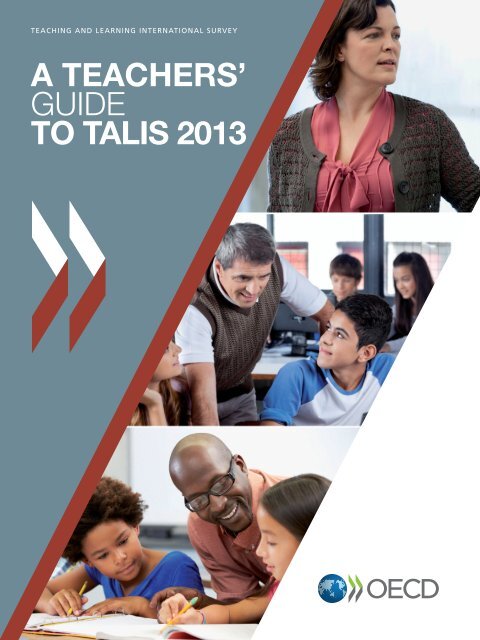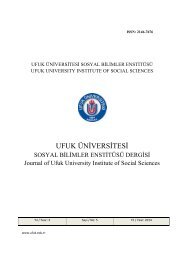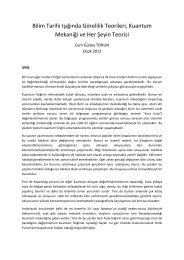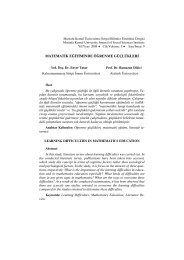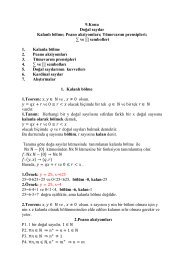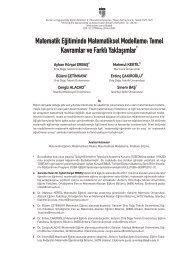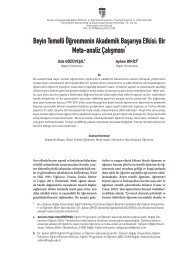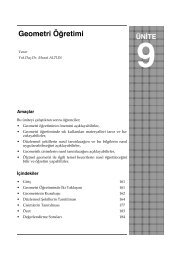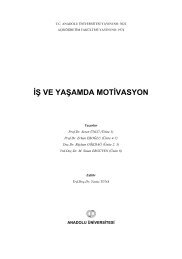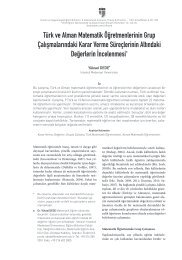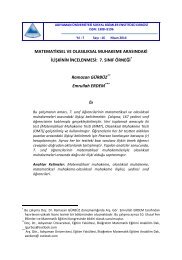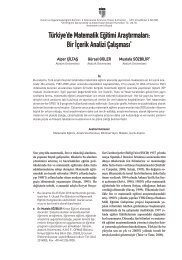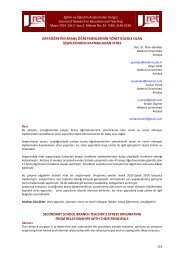TALIS-Teachers-Guide
TALIS-Teachers-Guide
TALIS-Teachers-Guide
- No tags were found...
Create successful ePaper yourself
Turn your PDF publications into a flip-book with our unique Google optimized e-Paper software.
TEACHING AND LEARNING INTERNATIONAL SURVEY<br />
A <strong>Teachers</strong>’<br />
<strong>Guide</strong><br />
to <strong>TALIS</strong> 2013
A <strong>Teachers</strong>’<br />
<strong>Guide</strong><br />
to <strong>TALIS</strong> 2013<br />
TEACHING AND LEARNING INTERNATIONAL SURVEY
This work is published on the responsibility of the Secretary-General of the OECD. The<br />
opinions expressed and arguments employed herein do not necessarily reflect the official<br />
views of the OECD member countries.<br />
This document and any map included herein are without prejudice to the status of or<br />
sovereignty over any territory, to the delimitation of international frontiers and boundaries<br />
and to the name of any territory, city or area.<br />
Please cite this publication as:<br />
OECD (2014), A <strong>Teachers</strong>’ <strong>Guide</strong> to <strong>TALIS</strong> 2013: Teaching and Learning International Survey, <strong>TALIS</strong>, OECD Publishing.<br />
http://dx.doi.org/10.1787/9789264216075-en<br />
ISBN 978-92-64-21608-2 (print)<br />
ISBN 978-92-64-21607-5 (PDF)<br />
<strong>TALIS</strong><br />
ISSN: 2312-962X (print)<br />
ISSN: 2312-9638 (online)<br />
Note by Turkey: The information in this document with reference to “Cyprus” relates to the southern part of the Island.<br />
There is no single authority representing both Turkish and Greek Cypriot people on the Island. Turkey recognises the<br />
Turkish Republic of Northern Cyprus (TRNC). Until a lasting and equitable solution is found within the context of the<br />
United Nations, Turkey shall preserve its position concerning the “Cyprus issue”.<br />
Note by all the European Union Member States of the OECD and the European Union: The Republic of Cyprus is<br />
recognised by all members of the United Nations with the exception of Turkey. The information in this document<br />
relates to the area under the effective control of the Government of the Republic of Cyprus.<br />
The statistical data for Israel are supplied by and under the responsibility of the relevant Israeli authorities. The use of<br />
such data by the OECD is without prejudice to the status of the Golan Heights, East Jerusalem and Israeli settlements<br />
in the West Bank under the terms of international law.<br />
Photo credits:<br />
© Hero Images/Corbis<br />
© Monkey Busines/Fotolia<br />
© Tyler Olson/Shutterstock<br />
Corrigenda to OECD publications may be found on line at: www.oecd.org/publishing/corrigenda.<br />
© OECD 2014<br />
You can copy, download or print OECD content for your own use, and you can include excerpts from OECD publications, databases<br />
and multimedia products in your own documents, presentations, blogs, websites and teaching materials, provided that suitable<br />
acknowledgement of OECD as source and copyright owner is given. All requests for public or commercial use and translation rights<br />
should be submitted to rights@oecd.org. Requests for permission to photocopy portions of this material for public or commercial use<br />
shall be addressed directly to the Copyright Clearance Center (CCC) at info@copyright.com or the Centre français d’exploitation du droit de<br />
copie (CFC) at contact@cfcopies.com.
The skills that students need to contribute effectively to<br />
society are in constant change. Yet, our education systems are<br />
not keeping up with the fast pace of the world around us. Most<br />
schools look much the same today as they did a generation ago,<br />
and teachers themselves are often not developing the practices<br />
and skills necessary to meet the diverse needs of today’s learners…<br />
Recognising that education is the great equaliser in society, the<br />
challenge for all of us is to equip all teachers with the skills and<br />
tools they need to provide effective learning opportunities for<br />
their students.<br />
Angel Gurría<br />
OECD Secretary-General<br />
© OECD 2014 A <strong>Teachers</strong>’ guide TO <strong>TALIS</strong> 3
Who are our<br />
teachers<br />
68% are women<br />
91% completed university or other<br />
equivalent higher education<br />
90% completed a teacher education<br />
or training programme<br />
82% are employed full time<br />
and 83% have a permanent contract<br />
88% report that they had participated<br />
in at least one professional development<br />
activity during the 12 months prior to<br />
the survey<br />
This teacher…<br />
Is 43 years old, on average<br />
Has an average of 16 years<br />
of teaching experience<br />
Teaches in a class with 24 students,<br />
on average<br />
Spends an average of 38 hours per<br />
week working<br />
Who are our<br />
school<br />
leaders<br />
51% are men<br />
96% completed university or<br />
other equivalent higher education<br />
90% completed a teacher education or<br />
training programme, 85% completed a<br />
school administration/principal training<br />
programme, and 78% completed<br />
instructional leadership training<br />
62% are employed full time without<br />
teaching obligations, and<br />
35% are employed full time with<br />
teaching obligations<br />
This school leader…<br />
Is 52 years old, on average<br />
Has an average of 9 years<br />
of experience as a principal<br />
and 21 years of teaching experience<br />
Works in a school with 546 students<br />
and 45 teachers, on average<br />
Profiles based on averages of lower secondary teachers / school leaders in <strong>TALIS</strong>-participating countries and economies<br />
4<br />
© OECD 2014 A <strong>Teachers</strong>’ guide TO <strong>TALIS</strong>
What is <strong>TALIS</strong><br />
The OECD Teaching and Learning International Survey (<strong>TALIS</strong>) is a largescale<br />
international survey that focuses on the working conditions of<br />
teachers and the learning environment in schools. <strong>TALIS</strong>, a collaboration<br />
among participating countries and economies, the OECD, an international<br />
research consortium, social partners and the European Commission, aims to<br />
provide valid, timely and comparable information to help countries review<br />
and define policies for developing a high-quality teaching workforce.<br />
<strong>TALIS</strong> examines the ways in which teachers’ work is recognised, appraised<br />
and rewarded, and assesses teachers’ participation in professional development<br />
activities. The study provides insights into teachers’ beliefs about<br />
and attitudes towards teaching, the pedagogical practices that they adopt,<br />
and the factors related to teachers’ sense of self-efficacy and job satisfaction.<br />
<strong>TALIS</strong> also examines the roles of school leaders and the support they give<br />
their teachers.<br />
The first cycle of <strong>TALIS</strong> was conducted in 2008 and surveyed teachers<br />
and school leaders of lower secondary education in 24 countries. In 2013,<br />
34 countries and economies participated in <strong>TALIS</strong>.<br />
© OECD 2014 A <strong>Teachers</strong>’ guide TO <strong>TALIS</strong> 5
Key features of <strong>TALIS</strong> 2013<br />
Participating countries and economies<br />
OECD countries: Alberta (Canada), Australia, Chile, the Czech Republic,<br />
Denmark, England (United Kingdom), Estonia, Finland, Flanders (Belgium),<br />
France, Iceland, Israel*, Italy, Japan, Korea, Mexico, the Netherlands, Norway,<br />
Poland, Portugal, the Slovak Republic, Spain, Sweden and the United<br />
States**.<br />
Partner countries and economies: Abu Dhabi (United Arab Emirates),<br />
Brazil, Bulgaria, Croatia, Cyprus***, Latvia, Malaysia, Romania, Serbia and<br />
Singapore.<br />
Participants<br />
Lower secondary teachers and leaders of schools in 200 schools per country/<br />
economy were randomly selected (20 teachers and 1 school leader per<br />
school). Some 107 000 lower secondary teachers responded to the survey,<br />
representing more than 4 million teachers in more than 30 participating<br />
countries and economies.<br />
The survey<br />
The survey was conducted between September and December 2012 for<br />
countries in the southern hemisphere and between February and June 2013<br />
for countries in the northern hemisphere.<br />
The questionnaire, which took between 45 and 60 minutes to complete,<br />
either on paper or on line, covered the following issues:<br />
• School leadership, including distributed or team leadership<br />
• Teacher training, including professional development and initial teacher<br />
education<br />
• Appraisal of and feedback to teachers<br />
• <strong>Teachers</strong>’ pedagogical beliefs, attitudes and teaching practices, including<br />
student-assessment practices<br />
• <strong>Teachers</strong>’ reported feelings of self-efficacy, job satisfaction and the climate<br />
in the schools and classrooms in which they work<br />
* The statistical data for Israel are supplied by<br />
and under the responsibility of the relevant<br />
Israeli authorities. The use of such data by<br />
the OECD is without prejudice to the status<br />
of the Golan Heights, East Jerusalem and<br />
Israeli settlements in the West Bank under<br />
the terms of international law.<br />
** Data from the United States are only<br />
included in selected charts in this publication<br />
and are not included in the calculations for<br />
the international average. This is because the<br />
United States did not meet the international<br />
standards for participation rates. However,<br />
U.S. participation rates were sufficiently high<br />
to report the U.S. data independently.<br />
*** Note by Turkey: The information in this<br />
document with reference to “Cyprus”<br />
relates to the southern part of the Island.<br />
There is no single authority representing<br />
both Turkish and Greek Cypriot people on<br />
the Island. Turkey recognises the Turkish<br />
Republic of Northern Cyprus (TRNC). Until<br />
a lasting and equitable solution is found<br />
within the context of the United Nations,<br />
Turkey shall preserve its position concerning<br />
the “Cyprus issue”.<br />
Note by all the European Union Member<br />
States of the OECD and the European Union:<br />
The Republic of Cyprus is recognised by all<br />
members of the United Nations with the<br />
exception of Turkey. The information in this<br />
document relates to the area under the<br />
effective control of the Government of the<br />
Republic of Cyprus.<br />
6<br />
© OECD 2014 A <strong>Teachers</strong>’ guide TO <strong>TALIS</strong>
<strong>Teachers</strong> are at the heart of <strong>TALIS</strong>. While the survey offers<br />
a wealth of information to education policy makers, it can<br />
also be seen as a global “selfie” by teachers: a snapshot, taken<br />
by teachers themselves, of what they believe, how they work,<br />
and how they feel about the work they do. Even more, through<br />
<strong>TALIS</strong> results, teachers in one country can gain an understanding of what<br />
their peers elsewhere in their own country and in other countries are doing,<br />
and maybe even be inspired by them.<br />
This publication not only presents the main results of <strong>TALIS</strong> 2013, it also<br />
takes those findings and, backed by the research literature on education<br />
and the large body of OECD work on education, offers insights and advice to<br />
teachers and school leaders on how they can improve teaching and learning<br />
in their schools. It is both a guide through <strong>TALIS</strong> and a handbook for building<br />
excellence into teaching.<br />
What do teachers believe about student learning<br />
<strong>Teachers</strong> walk into a classroom with an established set of<br />
beliefs on how students learn. These beliefs, developed<br />
in teacher training programmes and/or through teachers’<br />
own classroom experience, shape how teachers teach.<br />
For example, if teachers are convinced that students<br />
learn better when they are encouraged to think through<br />
and solve a problem on their own, before a teacher<br />
intervenes, then they are likely to use more active,<br />
student-centred approaches to teaching and learning,<br />
such as having students work in small groups, or<br />
requiring students to work on a project that takes more<br />
than a week to complete.<br />
Some 93% of teachers report that they believe that<br />
students should be allowed to think of solutions to a<br />
problem themselves before teachers show them the<br />
solution. In Italy, Norway, and Sweden, however, only<br />
between 45% and 59% of teachers agree that students<br />
learn best by trying to solve problems on their own.<br />
<strong>TALIS</strong> also finds that teachers who report that they<br />
encourage their students to work in small groups<br />
frequently or in all their lessons are more likely to report<br />
that they believe strongly in student-centred learning than<br />
those who never or only occasionally have their students<br />
work in small groups. Nearly half (47%) of the teachers<br />
surveyed, on average, report that they frequently have their<br />
students work in small groups.<br />
© OECD 2014 A <strong>Teachers</strong>’ guide TO <strong>TALIS</strong> 7
What do teachers do in the classroom<br />
How teachers’ working hours are regulated by education<br />
authorities varies among countries; it also has an impact<br />
on their actual working hours.<br />
Across the countries and economies that participated<br />
in <strong>TALIS</strong>, teachers report that they spend an average of<br />
38 hours per week working, ranging from 29 hours<br />
in Chile and Italy to 54 hours in Japan.<br />
> Chart page 10<br />
Ideally, teachers should spend most of their working time<br />
with students.<br />
<strong>Teachers</strong> surveyed by <strong>TALIS</strong> report that they spend most<br />
of their working hours (an average of 19 hours per<br />
week) teaching. This ranges from 15 hours in Norway<br />
to 27 hours in Chile. In most participating countries/<br />
economies, half of the teachers report that they spend<br />
80% or more of their lesson time on teaching and<br />
learning.<br />
Japanese teachers report spending only 18 hours per<br />
week teaching, which means that they spend considerably<br />
more time than their counterparts in other countries on<br />
tasks other than teaching. By contrast, teachers in Alberta<br />
(Canada) report that they spend an average of 26 hours<br />
per week teaching, teachers in Brazil, an average of<br />
25 hours per week teaching, and teachers in Chile and<br />
the United States, an average of 27 hours per week<br />
teaching – which may mean that they have little time for<br />
other tasks, such as lesson planning, marking students’<br />
work, or meeting with students and parents. In addition,<br />
according to their reports, teachers in the United States<br />
and Alberta (Canada) work longer hours, overall, than their<br />
peers in other countries.<br />
But as every teacher knows, there’s more involved in a<br />
workweek than actual teaching.<br />
<strong>Teachers</strong> report that they spend an average of 7 hours<br />
per week planning or preparing lessons (from 5 hours<br />
in Finland, Israel, Italy, the Netherlands and Poland, to<br />
10 hours in Croatia), an average of 5 hours per<br />
week marking students’ work (10 hours in Portugal and<br />
9 hours in Singapore), and an average of 2 hours per<br />
week each on school management, working with parents,<br />
and extracurricular activities.<br />
8<br />
© OECD 2014 A <strong>Teachers</strong>’ guide TO <strong>TALIS</strong>
Administrative tasks and disciplining disruptive students<br />
also take time away from teaching.<br />
In about half of the <strong>TALIS</strong>-participating countries/<br />
economies, one in four teachers reports spending at<br />
least 30% of lesson time handling classroom disruptions<br />
and administrative tasks. In Brazil, Chile, Malaysia and<br />
Singapore, one in four teachers reports spending at<br />
least 40% of lesson time on these tasks.<br />
One in two teachers in Brazil, Malaysia and Singapore<br />
reports spending 15% or more of lesson time on keeping<br />
order in the classroom. In contrast, one in two teachers<br />
in Bulgaria, Croatia, the Czech Republic, Estonia, Latvia,<br />
Poland and Romania reports spending 5% or less of lesson<br />
time on keeping order. Nearly one in three teachers,<br />
on average, reports losing “quite a lot of time” due to<br />
behavioural problems or waiting for students to settle<br />
down. Just over one in four teachers (26%) report<br />
that there is a lot of disruptive noise in their classrooms.<br />
The climate in the classroom has a strong impact on how<br />
confident teachers feel about their own ability to teach<br />
and on their overall job satisfaction.<br />
<strong>TALIS</strong> finds that teachers who report that they teach classes<br />
where more than one in ten students are low academic<br />
achievers or have behavioural problems report significantly<br />
less confidence in their teaching abilities (lower selfefficacy)<br />
and report less job satisfaction.<br />
What<br />
teachers<br />
can do<br />
• Expand their knowledge of<br />
pedagogy in the subjects they<br />
teach; that may free them<br />
to explore the use of active,<br />
student-centred teaching<br />
practices, such as having<br />
students work in small groups<br />
or having them work on projects<br />
that take longer than a week to<br />
complete.<br />
• Engage in some kind of<br />
professional development<br />
activity – whether attending<br />
workshops and conferences,<br />
observing other teachers,<br />
individual or collaborative<br />
research, or mentoring – as<br />
<strong>TALIS</strong> results show that teachers<br />
who do engage in these types<br />
of activities are more likely to<br />
use student-centred teaching<br />
practices.<br />
• Participate in mentoring systems<br />
to enhance co-operation<br />
among colleagues, build trust<br />
and promote a positive school<br />
climate. Co-operation is not only<br />
a way of sharing and comparing<br />
teaching practices, it can also<br />
lead to the development of more<br />
effective responses to student<br />
misbehaviour and disruptions in<br />
class.<br />
• Report to the school leader on<br />
daily or weekly inefficiencies,<br />
such as administrative tasks that<br />
might be performed by support<br />
staff or automated, so that more<br />
time can be devoted to teaching.<br />
© OECD 2014 A <strong>Teachers</strong>’ guide TO <strong>TALIS</strong> 9
Average hours spent working and teaching per week<br />
Average number of 60-minute hours teachers report that<br />
they spent on teaching during the most recent complete<br />
calendar week<br />
Total working hours<br />
Hours spent on teaching<br />
Hours per week<br />
0 10 20 30 40 50<br />
United States<br />
Chile<br />
Alberta (Canada)<br />
Brazil<br />
Mexico<br />
Abu Dhabi (United Arab Emirates)<br />
Estonia<br />
Portugal<br />
Finland<br />
Slovak Republic<br />
England (United Kingdom)<br />
Croatia<br />
Average<br />
Latvia<br />
Flanders (Belgium)<br />
Iceland<br />
Denmark<br />
Korea<br />
Spain<br />
Poland<br />
France<br />
Australia<br />
Bulgaria<br />
Serbia<br />
Israel<br />
Czech Republic<br />
Japan<br />
Sweden<br />
Italy<br />
Singapore<br />
Malaysia<br />
Netherlands<br />
Romania<br />
Norway<br />
0 10 20 30 40 50<br />
Countries are ranked in descending order of hours spent on teaching.<br />
Source: OECD, <strong>TALIS</strong> 2013 Database.<br />
10<br />
© OECD 2014 A <strong>Teachers</strong>’ guide TO <strong>TALIS</strong>
How do school leaders support their teachers<br />
School principals are the link between teachers, students<br />
and their parents or guardians, the education system<br />
and the wider community. Many also see principals as<br />
contributing to student achievement through their impact<br />
on how the school is organised, on the climate in the<br />
school and, especially, on teachers and teaching. School<br />
leaders can set the tone for teachers by encouraging<br />
teachers to co-operate with each other to develop new<br />
teaching practices and take responsibility for improving<br />
their teaching skills, and by ensuring that teachers feel<br />
responsible for their students’ learning outcomes. These<br />
practices are part of what is known as instructional<br />
leadership, which is considered by many educators to be<br />
the most important of all principals’ tasks.<br />
By encouraging teachers to learn from one another,<br />
principals help teachers to keep their teaching methods<br />
up-to-date and may also help to develop more<br />
collaboration among teachers in their schools.<br />
<strong>TALIS</strong> finds that an average of 64% of principals report<br />
that they frequently take action to support co-operation<br />
among teachers to develop new teaching practices.<br />
In Chile, Malaysia, Romania, Serbia, the Slovak Republic<br />
and Abu Dhabi (United Arab Emirates), between 80% and<br />
98% of principals report that they frequently support<br />
co-operation among their teachers to develop new<br />
practices, while in Denmark, Estonia, Japan, the Netherlands<br />
and Flanders (Belgium), more than 50% of principals<br />
report that they never, rarely or only sometimes do this.<br />
<strong>TALIS</strong> also finds that when principals exhibit greater<br />
instructional leadership, they are also more likely to<br />
develop a professional development plan for their school<br />
(this relationship was observed in 13 countries), sit in<br />
on classes and observe them as part of a formal teacher<br />
appraisal system (20 countries), and report there is<br />
a high level of mutual respect among colleagues at the<br />
school (19 countries). These principals also tend to<br />
spend more time on curriculum and teaching-related tasks.<br />
What<br />
school<br />
leaders<br />
can do<br />
• Participate in instructional<br />
leadership training. More than<br />
one in five (22%) principals report<br />
that they had never participated<br />
in instructional training, and 31%<br />
report that they had, but only<br />
after becoming a principal.<br />
• Give teachers the opportunity<br />
to participate in professional<br />
development activities, both<br />
those related to improving their<br />
practice and those that focus<br />
on using class time effectively.<br />
These activities can – and<br />
should – include collaboration<br />
and mentoring activities within<br />
the school itself. They build<br />
trust, encourage co-operation<br />
and promote a positive school<br />
climate.<br />
© OECD 2014 A <strong>Teachers</strong>’ guide TO <strong>TALIS</strong> 11
Teacher co-operation<br />
Percentage of lower secondary teachers who report that they<br />
Exchange and co-ordination for teaching<br />
Never engage in discussions<br />
about the learning<br />
development of specific<br />
students<br />
Never exchange teaching<br />
materials with colleagues<br />
Never work with other<br />
teachers in the school to<br />
ensure common standards<br />
in evaluations for assessing<br />
student progress<br />
Never attend team<br />
conferences<br />
Professional collaboration<br />
Never observe other<br />
teachers’ classes and provide<br />
feedback<br />
Never teach as a team in the<br />
same class<br />
Never engage in joint<br />
activities across different<br />
classes and age groups<br />
(e.g. projects)<br />
Never take part in<br />
collaborative professional<br />
learning<br />
40 20 0<br />
0 20 40 60 80<br />
Spain<br />
Iceland<br />
France<br />
Brazil<br />
Flanders (Belgium)<br />
Portugal<br />
Finland<br />
Croatia<br />
Italy<br />
Israel<br />
Sweden<br />
Mexico<br />
Chile<br />
Alberta (Canada)<br />
United States<br />
Norway<br />
Denmark<br />
Average<br />
Australia<br />
Malaysia<br />
Czech Republic<br />
Bulgaria<br />
Estonia<br />
Netherlands<br />
Serbia<br />
Slovak Republic<br />
Abu Dhabi (United Arab Emirates)<br />
Singapore<br />
England (United Kingdom)<br />
Poland<br />
Romania<br />
Latvia<br />
Japan<br />
Korea<br />
40 20 0<br />
Countries are ranked in descending order of the percentage of teachers who report that they never<br />
observe other teachers’ classes and provide feedback. Source: OECD, <strong>TALIS</strong> 2013 Database.<br />
0 20 40 60 80<br />
12<br />
© OECD 2014 A <strong>Teachers</strong>’ guide TO <strong>TALIS</strong>
To what extent do teachers participate<br />
in professional development activities<br />
No matter how good initial teacher education is, it cannot<br />
be expected to prepare teachers for all the challenges<br />
they will face during their first job as a teacher. Induction<br />
and mentoring programmes can provide teachers new to<br />
a school or new to teaching with invaluable assistance as<br />
they face their first students.<br />
<strong>TALIS</strong> results find that around 75% of teachers work in<br />
schools whose principals report that informal induction<br />
programmes are offered, and the same proportion<br />
work in schools whose principals report that mentoring<br />
programmes are available. In Australia, Malaysia, the<br />
Netherlands, Singapore, England (United Kingdom) and<br />
Flanders (Belgium), formal induction programmes are<br />
virtually universal for all teachers new to a school. While<br />
at least nine out of ten teachers in Australia, Finland,<br />
Iceland, Malaysia, Singapore and Flanders (Belgium) are<br />
in schools that offer informal induction activities for new<br />
teachers, fewer than 40% teachers in Japan and Mexico<br />
work in schools that offer these activities.<br />
But only around one in two teachers reports that he<br />
or she had participated in a formal induction programme.<br />
This indicates a significant difference between the<br />
reported availability of these programmes and teachers’<br />
participation in them.<br />
Some 14% of teachers, on average, report that they<br />
currently serve as mentors for other teachers; but in<br />
19 participating countries and economies, fewer than<br />
one in ten teachers reports that he or she currently<br />
enjoys the support of a mentor.<br />
> Charts pages 15 and 17<br />
But for teachers, learning doesn’t stop once teaching<br />
begins. Professional development, at all points in a<br />
teacher’s career, is necessary to keep up with changing<br />
research, tools, practices and students’ needs. And there is<br />
no better way to communicate to students the importance<br />
of lifelong learning than by teachers, themselves, setting<br />
the example of being lifelong learners.<br />
Nearly nine in ten (88%) teachers report that they had<br />
participated in at least one professional development<br />
activity during the 12 months prior to the survey. Some<br />
71% report that they had participated in at least one<br />
course or workshop, 44% report that they had attended<br />
an education conference or seminar, and 37% report that<br />
they had participated in a teacher network.<br />
What<br />
teachers<br />
can do<br />
• Participate in induction<br />
programmes, mentoring<br />
programmes and other<br />
professional development<br />
activities when they’re offered.<br />
• If these programmes are not<br />
offered in the school, encourage<br />
school leaders to make them<br />
available. These activities do<br />
not have to be costly or involve<br />
external experts. For example,<br />
collaboration among teachers<br />
within a school can result in<br />
effective mentoring systems.<br />
<strong>Teachers</strong> should participate,<br />
both as mentors and as mentees,<br />
regardless of their level of work<br />
experience. They could also<br />
form or join already established<br />
collaborative research groups<br />
and teacher networks, and/or<br />
simply observe their colleagues<br />
as they teach.<br />
© OECD 2014 A <strong>Teachers</strong>’ guide TO <strong>TALIS</strong> 13
Large proportions of teachers report that they had<br />
participated in professional development activities that<br />
focused on their knowledge and understanding of their<br />
subject (73%) or that focused on their pedagogical skills<br />
in teaching their subject (68%). And in almost all <strong>TALIS</strong>participating<br />
countries and economies, around nine in<br />
ten teachers report that the professional development<br />
activity that focused on their knowledge and understanding<br />
of their subject and on their pedagogical skills had a<br />
moderate or large positive impact on their teaching.<br />
Some 22% of teachers report that they would like more<br />
professional development activities related to teaching<br />
students with special needs (in Brazil, 60% of teachers<br />
report so, and in Mexico, 47% of teachers do). Yet only<br />
32% of teachers report that they had participated in such<br />
activities. The second and third most often cited areas for<br />
further learning are related to teaching with information<br />
and communication technologies (ICT) (19% of teachers<br />
so report) and to using new technologies in the workplace<br />
(18% of teachers).<br />
> Chart page 16<br />
But what accounts for the discrepancy between the<br />
availability of professional development activities and<br />
teachers’ participation in them<br />
<strong>TALIS</strong> finds that, across participating countries and<br />
economies, teachers most often cite conflicts with their<br />
work schedule (51% of teachers) and a lack of incentives<br />
(48%) as barriers to participating in professional<br />
development activities.<br />
At least three out of four teachers in Japan (86%), Korea<br />
(83%) and Portugal (75%) cite conflicts with their<br />
work schedule, while large proportions of teachers in Italy<br />
(83%), Portugal (85%) and Spain (80%) report a lack<br />
of incentives for participating. Some 44% of teachers, on<br />
average, consider professional development activities to be<br />
too expensive.<br />
> Chart page 17<br />
What<br />
school<br />
leaders<br />
can do<br />
• Offer formal induction<br />
programmes to all new teachers.<br />
• Encourage teachers to participate<br />
in mentoring programmes.<br />
School leaders should give<br />
teachers the time to participate<br />
in these programmes and<br />
arrange pairings of mentors/<br />
mentees who teach the same<br />
subject.<br />
• Give teachers the support<br />
they need to participate in<br />
professional development<br />
activities. Such support can<br />
include paying fees, scheduling<br />
time for training during the<br />
school day, modifying the school<br />
schedule to allow for teamteaching<br />
or peer observation<br />
and feedback, and recognising<br />
teachers’ participation in<br />
these activities in front of the<br />
teachers’ colleagues. Creating<br />
opportunities for professional<br />
development activities within<br />
the school or among nearby<br />
schools can be a relatively<br />
inexpensive way of promoting<br />
lifelong learning and fostering<br />
co-operation among teachers.<br />
14<br />
© OECD 2014 A <strong>Teachers</strong>’ guide TO <strong>TALIS</strong>
New teachers’ access to and participation in formal<br />
induction programmes<br />
Percentage of lower secondary teachers who have less than three years of<br />
experience at their school and less than three years of experience as a teacher<br />
who are working in schools whose principal reports that teachers have access<br />
to formal induction programmes, and the percentage of these teachers who<br />
report that they have participated in such programmes 1,2<br />
Access<br />
Participation<br />
Percentage of teachers<br />
20 40 60 80 100<br />
Iceland<br />
Finland<br />
Serbia<br />
Japan<br />
Slovak Republic<br />
Netherlands<br />
Norway<br />
Alberta (Canada)<br />
Flanders (Belgium)<br />
Australia<br />
United States<br />
Croatia<br />
Korea<br />
Average<br />
Chile<br />
Israel<br />
Malaysia<br />
England (United Kingdom)<br />
Romania<br />
Czech Republic<br />
Singapore<br />
20 40 60 80 100<br />
Countries are ranked in descending order of the gap between access to and<br />
participation in induction programmes. Countries are not presented in this graph if the<br />
percentage of teachers with less than three years of experience at their school and less<br />
than three years of experience as a teacher is below 5%.<br />
1. Data on access to induction programmes are derived from the principal<br />
questionnaire, while data on participation are derived from the teacher<br />
questionnaire. <strong>Teachers</strong> were asked about their participation in an induction<br />
programme in their first regular employment as a teacher.<br />
2. Data presented in this graph are for formal induction programmes only, meaning<br />
that they do not consider participation in or access to informal induction activities<br />
that are not part of an induction programme or a general and/or administrative<br />
introduction to the school.<br />
Source: OECD, <strong>TALIS</strong> 2013 Database.<br />
© OECD 2014 A <strong>Teachers</strong>’ guide TO <strong>TALIS</strong> 15
<strong>Teachers</strong>’ needs for professional development<br />
Percentage of lower secondary teachers reporting that<br />
they have a high need for professional development in:<br />
Percentage of teachers<br />
0 5 10 15 20 25<br />
Teaching students with special needs 1<br />
ICT skills for teaching<br />
New technologies in the workplace<br />
Student behaviour and classroom management<br />
Teaching in a multicultural or multilingual setting<br />
Approaches to individualised learning<br />
Student career guidance and counselling<br />
Student evaluation and assessment practice<br />
Teaching cross-curricular skills<br />
(e.g. problem solving, learning-to-learn)<br />
Approaches to developing cross-occupational<br />
competencies for future work or future studies<br />
Pedagogical competencies in teaching subject field(s)<br />
School management and administration<br />
Knowledge and understanding of the subject field(s)<br />
Knowledge of the curriculum<br />
Items are ranked in descending order of the percentage of teachers reporting that they have a high need for<br />
professional development.<br />
1. “Special needs students” are not well defined internationally but usually cover those for whom a<br />
special learning need has been formally identified because they are mentally, physically or emotionally<br />
disadvantaged. Often, special needs students will be those for whom additional public or private<br />
resources (personnel, material or financial) have been provided to support their education. “Gifted<br />
students” are not considered to have special needs under the definition used here and in other OECD<br />
work. Some teachers perceive all students as unique learners and thus have some special learning needs.<br />
That is why a formal identification is stressed above.<br />
Source: OECD, <strong>TALIS</strong> 2013 Database.<br />
16<br />
© OECD 2014 A <strong>Teachers</strong>’ guide TO <strong>TALIS</strong>
Availability of and participation in mentoring activities<br />
Percentage of teachers working in schools whose principal<br />
reports that mentoring programmes are available for all teachers<br />
in the school<br />
Netherlands<br />
Abu Dhabi (United Arab Emirates)<br />
Brazil<br />
Romania<br />
Slovak Republic<br />
Bulgaria England (United Kingdom)<br />
Australia<br />
Iceland<br />
Alberta (Canada)<br />
Singapore<br />
Czech Republic Korea<br />
Average<br />
Latvia<br />
Mexico<br />
Poland<br />
Portugal<br />
Japan<br />
Estonia Croatia<br />
United States Malaysia<br />
Spain Norway<br />
Chile<br />
Israel<br />
Flanders (Belgium)<br />
Finland<br />
Denmark<br />
France<br />
Italy Serbia<br />
Sweden<br />
0<br />
10 20 30 40 50 60 70<br />
Percentage of teachers who report that they currently have an assigned mentor to support them<br />
80<br />
70<br />
60<br />
50<br />
40<br />
30<br />
20<br />
10<br />
0<br />
Source: OECD, <strong>TALIS</strong> 2013 Database.<br />
Barriers to participation in professional development<br />
Percentage of lower secondary teachers who “strongly disagree”,<br />
“disagree”, “agree” or “strongly agree” with the following statements:<br />
Strongly agree<br />
Agree<br />
Strongly disagree<br />
Disagree<br />
Percentage of teachers<br />
0 10 20 30 40 50 60 70 80 90 100<br />
Professional development<br />
conflicts with my work schedule<br />
There are no incentives<br />
for participating in such activities<br />
Professional development<br />
is too expensive/unaffordable<br />
There is no relevant professional<br />
development offered<br />
Lack of time due to<br />
family responsibilities<br />
There is a lack of<br />
employer support<br />
Do not have the pre-requisites<br />
(e.g. qualifications, experience, seniority)<br />
Barriers to teachers’ participation in professional development activities are ranked in descending<br />
order of the percentage of teachers who “agree” or “strongly agree” with the statements.<br />
Source: OECD, <strong>TALIS</strong> 2013 Database.<br />
© OECD 2014 A <strong>Teachers</strong>’ guide TO <strong>TALIS</strong> 17
To what extent do schools use teacher appraisals<br />
Appraising teachers and providing them with feedback<br />
about their practices recognises and celebrates great<br />
teaching even as it challenges teachers to confront and<br />
address their weaknesses. Constructive and fair teacher<br />
appraisal and feedback have been shown to have a<br />
positive effect on teachers’ job satisfaction and on their<br />
feelings of self-efficacy.<br />
Some 88% of teachers, on average, report that they<br />
receive feedback in their school. But in Denmark, Finland,<br />
Iceland, Italy, Spain and Sweden between 22% and 45%<br />
of teachers report that they have never received feedback<br />
in their current school.<br />
More than one in two teachers (54%, on average) report<br />
receiving feedback from their school principal; slightly<br />
fewer (49%) report that they receive feedback from<br />
members of the school management team. Meanwhile,<br />
fewer than one in two teachers (42%) reports that he<br />
or she receives feedback from other teachers, and only<br />
29% of teachers report that they receive feedback from<br />
individuals or bodies external to their schools.<br />
Nearly 80% of teachers, on average, report that they<br />
receive feedback following some sort of classroom<br />
observation; but fewer than one in two teachers in<br />
Finland, Iceland, Italy and Spain reports receiving feedback<br />
following a classroom observation. In these countries,<br />
comparatively small proportions of teachers report that<br />
they receive any feedback in their school.<br />
> Chart page 20<br />
What<br />
teachers<br />
can do<br />
• Regard appraisals and feedback<br />
as tools to improve teaching<br />
practices to, in turn, improve<br />
student learning.<br />
• Work with other teachers<br />
to develop a system of peer<br />
feedback on all aspects of<br />
teaching, from lesson planning<br />
and classroom practice to<br />
student evaluation.<br />
18<br />
© OECD 2014 A <strong>Teachers</strong>’ guide TO <strong>TALIS</strong>
Appraising teachers and offering them feedback on<br />
their work is essential for improving individual teachers’<br />
performance in class; but these practices are only effective<br />
if they are tied to real and meaningful consequences.<br />
<strong>TALIS</strong> results find that while teacher feedback is related<br />
to changes in job responsibilities for most teachers,<br />
and career advancement for just over one in three<br />
teachers, on average, fewer teachers report that it is linked<br />
to their salary. On average, only one in four teachers<br />
reports that the feedback that he or she receives has had<br />
a moderate or large positive impact on his or her salary or<br />
that he or she has received a financial bonus as a result of<br />
feedback.<br />
On average across <strong>TALIS</strong>-participating countries and<br />
economies, 62% of teachers report that the feedback<br />
they receive in their school leads to moderate or large<br />
positive changes in their teaching practices: more than one<br />
in two teachers report moderate to large improvements in<br />
their use of student assessments (59%) and in classroom<br />
management practices (56%), and 45% of teachers<br />
report moderate or large improvements in the methods<br />
they use for teaching students with special needs.<br />
However, 43% of teachers, on average across <strong>TALIS</strong>participating<br />
countries and economies, report that the<br />
teacher appraisal and feedback system in their school has<br />
little impact on classroom teaching. Slightly more than one<br />
in two teachers report that teacher appraisal and feedback<br />
is largely undertaken to fulfil administrative requirements.<br />
> Chart page 21<br />
What<br />
school<br />
leaders<br />
can do<br />
• Foster a climate in which peer<br />
appraisal, in addition to direct<br />
feedback from the school leader<br />
or school management team,<br />
can take place. Collaborative<br />
exchanges among teachers offer<br />
good opportunities for teachers<br />
to learn about their own practice<br />
and find support for professional<br />
development.<br />
• Help teachers identify their<br />
individual professional<br />
development needs and<br />
incorporate these into the<br />
school’s priorities.<br />
© OECD 2014 A <strong>Teachers</strong>’ guide TO <strong>TALIS</strong> 19
<strong>Teachers</strong> who report that they have never received feedback<br />
Percentage of lower secondary teachers<br />
who report that they have not received<br />
feedback from certain appraisal practices<br />
Percentage of teachers<br />
Analysis of students’ test scores<br />
Assessment of content knowledge<br />
Direct classroom observation<br />
0 10 20 30 40 50 60 70 80 90 100<br />
Iceland<br />
Finland<br />
Sweden<br />
Flanders (Belgium)<br />
France<br />
Italy<br />
Denmark<br />
Netherlands<br />
Norway<br />
Spain<br />
Australia<br />
Croatia<br />
Alberta (Canada)<br />
United States<br />
Japan<br />
Portugal<br />
Average<br />
Israel<br />
England (United Kingdom)<br />
Chile<br />
Estonia<br />
Serbia<br />
Czech Republic<br />
Slovak Republic<br />
Mexico<br />
Singapore<br />
Brazil<br />
Korea<br />
Poland<br />
Abu Dhabi (United Arab Emirates)<br />
Bulgaria<br />
Romania<br />
Latvia<br />
Malaysia<br />
0 10 20 30 40 50 60 70 80 90<br />
Items are ranked in descending order of the percentage of teachers who report that they<br />
have never received feedback after an analysis of students’ test scores.<br />
Source: OECD, <strong>TALIS</strong> 2013 Database.<br />
20<br />
© OECD 2014 A <strong>Teachers</strong>’ guide TO <strong>TALIS</strong>
Outcomes of teacher feedback<br />
Percentage of lower secondary teachers who report a “moderate” or “large” positive change<br />
in the following after they receive feedback on their work at their school: 1<br />
Percentage of teachers<br />
0 10 20 30 40 50 60 70 80 90 100<br />
Confidence<br />
as a teacher<br />
Motivation<br />
Job satisfaction<br />
Personal<br />
Knowledge and<br />
understanding of<br />
main subject field(s)<br />
Teaching practices<br />
Student assessments<br />
to improve student<br />
learning<br />
Classroom<br />
management practices<br />
Pedagogical<br />
Methods for teaching<br />
students with<br />
special needs<br />
Public recognition<br />
Job responsibilities<br />
Role in school<br />
development<br />
initiatives<br />
Amount of<br />
professional<br />
development<br />
Professional<br />
Likelihood of career<br />
advancement<br />
Salary and/or financial<br />
bonus<br />
0 10 20 30 40 50 60 70 80 90 100<br />
1. Dots represent the lowest and highest values among participating countries. The middle dot represents the international<br />
average.<br />
Outcomes are ranked in descending order, in each group of outcomes, of the average percentage of teachers who report a<br />
“moderate” or “large” positive change in the selected areas after they receive feedback on their work at their school.<br />
Source: OECD, <strong>TALIS</strong> 2013 Database.<br />
© OECD 2014 A <strong>Teachers</strong>’ guide TO <strong>TALIS</strong> 21
Do our teachers feel confident in their ability to teach<br />
While <strong>TALIS</strong> doesn’t – and can’t – measure teachers’<br />
effectiveness in the classroom, it does ask teachers to<br />
describe their ability to manage their classes, provide<br />
instruction, and engage their students in learning.<br />
Research has shown that when teachers are more<br />
confident about their own abilities to teach (greater selfefficacy)<br />
their students tend to do better in school and are<br />
more motivated to learn, and the teachers, themselves,<br />
tend to use more effective instructional practices, have<br />
greater enthusiasm for, and are more committed to,<br />
teaching, and report greater job satisfaction. Equally,<br />
lower levels of self-efficacy among teachers are related<br />
to more problems with student misbehaviour, pessimism<br />
about student learning, greater job-related stress, and<br />
less job satisfaction.<br />
In the majority of <strong>TALIS</strong>-participating countries and<br />
economies, between 80% and 92% of teachers, on<br />
average, answer survey questions in a way that suggests<br />
that they have high levels of self-efficacy. <strong>Teachers</strong> in<br />
the Czech Republic, Japan, Korea, Norway and Spain,<br />
however, report less self-efficacy than average in several<br />
areas of their practice.<br />
In general, the more years of teaching experience, the<br />
greater the sense of self-efficacy.<br />
In most countries, more experienced teachers tend<br />
to report greater self-efficacy: in Denmark, France,<br />
Italy, Japan, Latvia, Singapore, Sweden, Abu Dhabi<br />
(United Arab Emirates), Alberta (Canada) and Flanders<br />
(Belgium), teachers’ sense of self-efficacy is much higher<br />
among those with more than five years of teaching<br />
experience compared to their less-experienced colleagues.<br />
With debate about the ideal class size still raging in many<br />
countries, <strong>TALIS</strong> finds that, when it comes to teachers’<br />
self-efficacy, it’s not the number of students but the<br />
kinds of students in their classes that has the strongest<br />
impact on teachers’ feelings of self-confidence.<br />
Class size seems to have only a minimal impact on teaching<br />
efficacy in just a few countries. But in many <strong>TALIS</strong>participating<br />
countries and economies, teachers who report<br />
that they teach classes where more than one in ten<br />
students are low academic achievers or have behavioural<br />
problems also report significantly lower levels of selfefficacy.<br />
<strong>TALIS</strong> results also show that, in many countries, the lower<br />
levels of self-efficacy that teachers report when they teach<br />
classes with larger proportions of low achievers or students<br />
with behavioural problems stem largely from the fact that<br />
they have to spend more time keeping order in the class –<br />
and thus, necessarily, less time actually teaching.<br />
22<br />
© OECD 2014 A <strong>Teachers</strong>’ guide TO <strong>TALIS</strong>
The quality of the relationships teachers have with their<br />
colleagues and their students also affects their selfconfidence.<br />
In all <strong>TALIS</strong>-participating countries, when teachers report<br />
more positive relationships with students and collaborative<br />
relationships with other teachers, they also report<br />
significantly higher levels of self-efficacy. In fact, in many<br />
countries, the association with self-efficacy is stronger<br />
with teacher-teacher relations than with teacher-student<br />
relations.<br />
Indeed, <strong>TALIS</strong> results show that good interpersonal<br />
relations in school can at least partly offset the negative<br />
impact on teachers’ sense of self-efficacy of teaching<br />
classes with significant proportions of low-achievers or<br />
students with behavioural problems.<br />
In Brazil, France, Italy, Mexico, Portugal, Romania, Serbia,<br />
Spain and Abu Dhabi (United Arab Emirates), the strength<br />
of the association between self-efficacy and teaching<br />
more low-achievers is weaker or no longer significant<br />
when teachers have good working relationships with their<br />
colleagues and students. In Australia, Croatia, the Czech<br />
Republic, Denmark, Israel, Poland, Portugal, Romania, Spain,<br />
Abu Dhabi (United Arab Emirates) and England (United<br />
Kingdom), the association between self-efficacy and<br />
teaching more students with behavioural problems is also<br />
weaker when teachers have good working relationships in<br />
school.<br />
When teachers have a say in how their school functions,<br />
they also tend to express higher levels of self-efficacy.<br />
In 20 countries, teachers who agree that staff at their<br />
school are given opportunities to participate in decision<br />
making report greater self-efficacy.<br />
Being well-prepared for teaching by participating in<br />
professional development activities, particularly those<br />
that focus on classroom management, instruction, and<br />
student engagement with learning, also has a positive<br />
impact on teachers’ self-efficacy.<br />
In 14 of the <strong>TALIS</strong>-participating countries, teachers who<br />
report that they had participated in a formal induction<br />
programme also report higher levels of self-efficacy; but<br />
in France, teachers who report that they had participated<br />
in such programmes report lower levels of self-efficacy.<br />
In Chile, the Czech Republic, Latvia and Norway, the<br />
relationship between self-efficacy and participation in a<br />
formal induction programme is moderately strong, while it<br />
is particularly strong in Poland.<br />
While participating in a mentoring system does not seem to<br />
be consistently related to greater self-efficacy, acting as a<br />
mentor tends to be related to higher levels of self-efficacy<br />
than being mentored. This relationship is particularly strong<br />
in France, Japan and Korea, where teachers who report<br />
that they are mentors to their colleagues also report much<br />
higher levels of self-efficacy.<br />
<strong>TALIS</strong> finds that teachers who collaborate more with their<br />
colleagues – teaching jointly in the same class, observing<br />
and providing feedback on each other’s classes, engaging<br />
in joint activities across different classes and age groups,<br />
and taking part in collaborative professional learning –<br />
report a greater sense of self-efficacy.<br />
In most countries, the association between teachers’<br />
self-efficacy and most collaborative activities is positive.<br />
Indeed, the association between teachers’ self-efficacy<br />
and participating in collaborative professional learning<br />
activities is strong, particularly in Bulgaria, Chile, Estonia,<br />
Finland, Israel and Korea.<br />
© OECD 2014 A <strong>Teachers</strong>’ guide TO <strong>TALIS</strong> 23
<strong>Teachers</strong>’ self-efficacy and professional collaboration<br />
Teach as a team in the same class<br />
Observe other teachers’ classes<br />
and provide feedback<br />
Engage in joint activities across different<br />
classes and age groups<br />
Take part in collaborative professional learning<br />
Low<br />
self-efficacy<br />
High<br />
self-efficacy<br />
Never<br />
Once a year or less<br />
2-4 times a year<br />
5-10 times a year<br />
1-3 times a month<br />
Once a week or more<br />
Source: OECD, <strong>TALIS</strong> 2013 Database.<br />
24<br />
© OECD 2014 A <strong>Teachers</strong>’ guide TO <strong>TALIS</strong>
Do our teachers derive satisfaction<br />
from their daily work, and from being teachers<br />
While more than nine out of ten (91%) teachers across<br />
<strong>TALIS</strong>-participating countries and economies report that,<br />
overall, they are satisfied with their jobs, and nearly eight<br />
in ten (78%) report that, if they had to make the decision<br />
again, they’d still choose to become teachers, fewer than<br />
one in three teachers believes that teaching is a valued<br />
profession in society. This perception can have a chilling<br />
effect on recruiting and retaining high-quality candidates<br />
for the teaching profession; but it is not immutable: in<br />
all but one <strong>TALIS</strong> country, teachers who participate more<br />
in decision making in their school are also more likely to<br />
report that society values the teaching profession.<br />
In Croatia, France, the Slovak Republic, Spain and Sweden,<br />
fewer than one in ten teachers believes that teaching<br />
is a valued profession. By contrast, in Korea, Malaysia,<br />
Singapore and Abu Dhabi (United Arab Emirates), at least<br />
two out of three teachers report that they believe<br />
their society values teaching as a profession.<br />
Not surprisingly, <strong>TALIS</strong> finds that, as with the sense of<br />
self-efficacy, teachers who report that they teach classes<br />
with large proportions of low-achievers or students with<br />
behavioural problems also report less job satisfaction.<br />
And, as with teachers’ self-confidence in their teaching<br />
abilities, much, if not all, of teachers’ dissatisfaction in<br />
the face of such challenging classrooms stems from<br />
the amount of time they have to spend managing<br />
unmotivated or disruptive students.<br />
However, <strong>TALIS</strong> also finds that, in these cases, the negative<br />
impact of these students’ behaviour on teachers’ job<br />
satisfaction can be mitigated when teachers have good<br />
relations with their colleagues and students.<br />
In fact, <strong>TALIS</strong> results show that having good relations with<br />
students has a stronger impact on teachers’ job satisfaction<br />
than having good relations with other teachers.<br />
> Chart page 26<br />
<strong>TALIS</strong> results show that teachers in most participating<br />
countries report greater job satisfaction when they<br />
receive feedback about classroom management and<br />
when they are appraised by at least two evaluators. <strong>TALIS</strong><br />
also finds that teachers who believe that appraisal and<br />
feedback have an impact on their teaching practices also<br />
report greater job satisfaction.<br />
In Bulgaria, the Czech Republic, Italy, Malaysia, Mexico,<br />
Norway, Poland, Romania, Singapore, Abu Dhabi (United<br />
Arab Emirates) and England (United Kingdom), the<br />
relationship between job satisfaction and teachers’<br />
perception that feedback influences their classroom<br />
practice is strong. By contrast, in all <strong>TALIS</strong>-participating<br />
countries and economies, when teachers perceive that<br />
appraisal and feedback are only administrative exercises,<br />
their job satisfaction plummets.<br />
What<br />
teachers<br />
can do<br />
• Be open to working together with<br />
colleagues and school leaders.<br />
If formal collaborative activities<br />
aren’t already established, take<br />
the initiative to create them.<br />
• Consider team teaching as a<br />
way of approaching classroom<br />
management, particularly<br />
when there are large numbers<br />
of students with behavioural<br />
problems in class.<br />
• Take advantage of professional<br />
development opportunities,<br />
especially if they are provided<br />
in the school and involve<br />
colleagues.<br />
© OECD 2014 A <strong>Teachers</strong>’ guide TO <strong>TALIS</strong> 25
<strong>Teachers</strong>’ job satisfaction and class composition<br />
Low job<br />
satisfaction<br />
Class size (number of students)<br />
High job<br />
satisfaction<br />
15 or fewer<br />
16-20<br />
21-25<br />
26-30<br />
31-35<br />
36 or more<br />
Low job<br />
satisfaction<br />
Students with behavioural problems<br />
High job<br />
satisfaction<br />
None<br />
1% to 10%<br />
11% to 30%<br />
31% or more<br />
Note: Data on class size and students with behavioural problems are reported by teachers<br />
and refer to a randomly chosen class they currently teach.<br />
Source: OECD, <strong>TALIS</strong> 2013 Database.<br />
26<br />
© OECD 2014 A <strong>Teachers</strong>’ guide TO <strong>TALIS</strong>
As for most professionals, teachers derive the most<br />
satisfaction from their work when they feel that they are<br />
treated as professionals, when their opinions are sought<br />
and valued, and when they feel they have a say in how<br />
they work.<br />
<strong>TALIS</strong> finds that, across all participating countries, when<br />
teachers report that they are given opportunities to<br />
participate in decision making at school they also report<br />
higher job satisfaction.<br />
Similarly, when teachers work closely with their<br />
colleagues, whether teaching or learning together, job<br />
satisfaction increases substantially.<br />
As with teacher self-efficacy, the strongest association<br />
between job satisfaction and collaboration with colleagues<br />
involves participating in collaborative professional learning<br />
activities. This relationship is observed in 2 out of 3<br />
participating countries/economies. In Brazil and Chile, this<br />
association appears to be exceptionally strong.<br />
> Chart page 28<br />
What<br />
school<br />
leaders<br />
can do<br />
• Develop meaningful appraisal<br />
and feedback systems that are<br />
linked to teachers’ practice and,<br />
ultimately, to improving teaching<br />
and learning.<br />
• Give teachers a say in how the<br />
school is managed. <strong>Teachers</strong><br />
who report that they are given<br />
opportunities to participate<br />
in decision making at school<br />
also report higher levels of<br />
job satisfaction in all <strong>TALIS</strong>participating<br />
countries and, in<br />
most countries, a greater sense<br />
of self-efficacy. <strong>Teachers</strong> are<br />
on the “front lines” of learning,<br />
and so may have a better idea<br />
than school leaders of how the<br />
curriculum is actually translated<br />
in class and how students are<br />
performing.<br />
• Provide opportunities and<br />
support to build relationships<br />
within the school. This support<br />
could be in the form of a physical<br />
space where teachers can meet<br />
or by setting aside time away<br />
from class or administrative<br />
work to allow teachers to meet<br />
and develop relationships with<br />
students or colleagues.<br />
• Encourage collaboration among<br />
teachers. <strong>TALIS</strong> data show that<br />
teachers benefit from collaboration<br />
with their colleagues, whether<br />
in professional development<br />
activities or team teaching.<br />
While collaboration may require<br />
adjustments to teachers’<br />
schedules, the benefits to teachers’<br />
practices – and to teachers’<br />
morale – are likely to outweigh any<br />
administrative inconveniences.<br />
© OECD 2014 A <strong>Teachers</strong>’ guide TO <strong>TALIS</strong> 27
<strong>Teachers</strong>’ job satisfaction and professional collaboration<br />
Teach as a team in the same class<br />
Observe other teachers’ classes<br />
and provide feedback<br />
Engage in joint activities across different<br />
classes and age groups<br />
Take part in collaborative professional learning<br />
Low job<br />
satisfaction<br />
High job<br />
satisfaction<br />
Never<br />
Once a year or less<br />
2-4 times a year<br />
5-10 times a year<br />
1-3 times a month<br />
Once a week or more<br />
Source: OECD, <strong>TALIS</strong> 2013 Database.<br />
28<br />
© OECD 2014 A <strong>Teachers</strong>’ guide TO <strong>TALIS</strong>
ORGANISATION FOR ECONOMIC CO-OPERATION<br />
AND DEVELOPMENT<br />
The OECD is a unique forum where governments work together to address the economic, social<br />
and environmental challenges of globalisation. The OECD is also at the forefront of efforts to understand<br />
and to help governments respond to new developments and concerns, such as corporate governance, the<br />
information economy and the challenges of an ageing population. The Organisation provides a setting<br />
where governments can compare policy experiences, seek answers to common problems, identify good<br />
practice and work to co-ordinate domestic and international policies.<br />
The OECD member countries are: Australia, Austria, Belgium, Canada, Chile, the Czech Republic,<br />
Denmark, Estonia, Finland, France, Germany, Greece, Hungary, Iceland, Ireland, Israel, Italy, Japan, Korea,<br />
Luxembourg, Mexico, the Netherlands, New Zealand, Norway, Poland, Portugal, the Slovak Republic, Slovenia,<br />
Spain, Sweden, Switzerland, Turkey, the United Kingdom and the United States. The European Union takes<br />
part in the work of the OECD.<br />
OECD Publishing disseminates widely the results of the Organisation’s statistics gathering and research<br />
on economic, social and environmental issues, as well as the conventions, guidelines and standards agreed<br />
by its members.<br />
OECD PUBLISHING, 2, rue André-Pascal, 75775 PARIS CEDEX 16<br />
(87 2014 02 1P) ISBN 978-92-64-21608-2 – 2014-06
For further information please visit our website:<br />
www.oecd.org/talis<br />
or contact us at:<br />
talis@oecd.org


